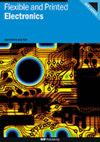High resistivity free-standing crosslinked graphene oxide substrates: hopping conduction mechanism and application to recyclable electronics
IF 3.2
4区 工程技术
Q3 MATERIALS SCIENCE, MULTIDISCIPLINARY
引用次数: 0
Abstract
Abstract Graphene oxide (GO) is an oxidized derivative of graphene that can be formed into free-standing wafers by aqueous processing methods. We propose GO as a potential alternative printed electronic substrate material to mitigate the waste electronic and electrical equipment problem. By dissolving these substrates in water, GO permits the mechanical separation and recovery of discrete components from defunct circuits, thus closing the life cycle of printed circuits. In this work we measure the anisotropic, frequency dependent resistivity of free-standing GO wafers under DC and AC ( f = 0.1 Hz–500 kHz) excitation and in varying relative humidity (RH) conditions. Unmodified GO and GO crosslinked with calcium ions, borate ions, and glutaraldehyde were characterized. AC resistivity measurements reveal charge transport in free-standing GO occurs by several distinct hopping conduction mechanisms that are sensitive to the crosslinking formulation. GO crosslinked with calcium ions exhibits the highest DC resistivity, 4.6 × 10 5 Ωm and 2.6 × 10 4 Ωm, for out-of-plane and in-plane directions, respectively, at 17% RH. Both AC and DC resistivities decrease with increasing RH. We demonstrate that GO wafers can be used as dielectric substrates in the construction of simple electronic circuits with discrete electronic components. Finally, we present a proof-of-concept for electrical trace and component recovery via disassembly of GO wafers in water.高电阻率独立交联氧化石墨烯衬底:跳传导机理及其在可回收电子产品中的应用
氧化石墨烯(GO)是石墨烯的氧化衍生物,可以通过水处理方法形成独立的晶圆。我们建议氧化石墨烯作为潜在的替代印刷电子衬底材料,以减轻废弃电子和电气设备的问题。通过将这些基板溶解在水中,氧化石墨烯允许从失效电路中机械分离和恢复离散元件,从而关闭印刷电路的生命周期。在这项工作中,我们测量了独立GO晶圆在直流和交流(f = 0.1 Hz-500 kHz)激励和不同相对湿度(RH)条件下的各向异性、频率相关电阻率。对未改性氧化石墨烯和与钙离子、硼酸盐离子和戊二醛交联的氧化石墨烯进行了表征。交流电阻率测量表明,独立氧化石墨烯中的电荷输运是通过几种不同的跳跃传导机制发生的,这些机制对交联配方很敏感。当相对湿度为17%时,与钙离子交联的氧化石墨烯在面外和平面内的直流电阻率分别为4.6 × 10 5 Ωm和2.6 × 10 4 Ωm。交流电阻率和直流电阻率都随相对湿度的增加而降低。我们证明了氧化石墨烯晶圆可以用作介质衬底,用于构建具有离散电子元件的简单电子电路。最后,我们提出了通过在水中拆卸氧化石墨烯晶圆来实现电痕迹和组件回收的概念验证。
本文章由计算机程序翻译,如有差异,请以英文原文为准。
求助全文
约1分钟内获得全文
求助全文
来源期刊

Flexible and Printed Electronics
MATERIALS SCIENCE, MULTIDISCIPLINARY-
CiteScore
4.80
自引率
9.70%
发文量
101
期刊介绍:
Flexible and Printed Electronics is a multidisciplinary journal publishing cutting edge research articles on electronics that can be either flexible, plastic, stretchable, conformable or printed. Research related to electronic materials, manufacturing techniques, components or systems which meets any one (or more) of the above criteria is suitable for publication in the journal. Subjects included in the journal range from flexible materials and printing techniques, design or modelling of electrical systems and components, advanced fabrication methods and bioelectronics, to the properties of devices and end user applications.
 求助内容:
求助内容: 应助结果提醒方式:
应助结果提醒方式:


